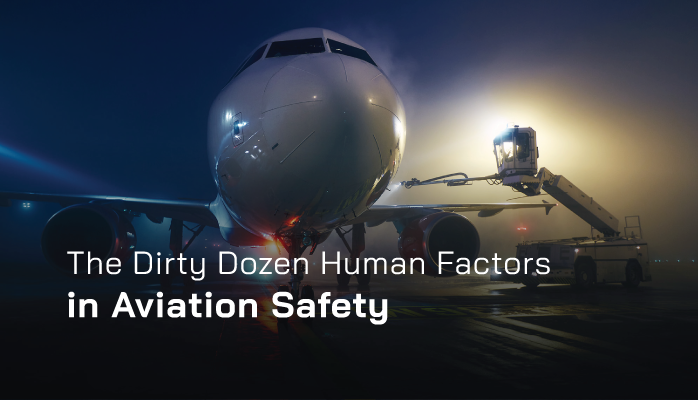The Dirty Dozen Human Factors in Aviation Safety

Aviation safety is a complex field where human factors play a pivotal role in preventing accidents and ensuring operational efficiency.
The "Dirty Dozen," a concept developed by Gordon Dupont in 1993 for Transport Canada, identifies twelve common human error preconditions that can lead to incidents in aviation. These factors, ranging from lack of communication to fatigue, are critical for aviation safety managers to understand and address.
This article provides a comprehensive guide to the Dirty Dozen, offering detailed explanations, real-world examples, and actionable strategies to mitigate risks, tailored for aviation safety managers.
Introduction to the Dirty Dozen
The Dirty Dozen framework was created to highlight human factors that degrade performance and increase the likelihood of errors in aviation, particularly in maintenance. Since its inception, it has been adopted across various aviation sectors, including flight operations and air traffic control, as a cornerstone of human factors training.
According to the Federal Aviation Administration (FAA), approximately 80% of maintenance errors involve human factors, and the Dirty Dozen provides a practical tool to address these issues (FAA Human Factors).
The twelve factors are not exhaustive—ICAO Circular 240-AN/144 lists over 300 human error precursors—but they are among the most common and impactful. They are: Lack of Communication, Distraction, Lack of Resources, Stress, Complacency, Lack of Teamwork, Pressure, Lack of Awareness, Lack of Knowledge, Fatigue, Lack of Assertiveness, and Norms. Below, we explore each factor in detail, including its definition, impact, examples, and mitigation strategies.
Related Human Factors Articles
- Let’s Talk Human Factors - Origin of Dirty Dozen
- Let’s Talk Human Factors - Lack of Communication
- Let’s Talk Human Factors: Distraction Is #4 of the Dirty Dozen
1. Lack of Communication
Definition
Lack of communication occurs when information is not effectively transmitted, received, or understood between individuals or teams.
Impact
Poor communication can lead to misunderstandings, incomplete tasks, and critical errors. Research indicates that only 30% of verbal messages are accurately received and understood, making this a top contributor to aviation incidents (SKYbrary Dirty Dozen).
Example
The Tenerife airport disaster in 1977, where two Boeing 747s collided on the runway, killing 583 people, was partly due to miscommunication between pilots and air traffic control. Ambiguous radio transmissions led to one aircraft initiating takeoff while another was still on the runway.
Mitigation
- Use written instructions for complex tasks, such as logbooks or checklists.
- Confirm verbal communications by repeating critical information.
- Encourage a culture where questions and clarifications are welcomed.
2. Distraction
Definition
Distraction is anything that diverts attention from the primary task, whether unavoidable (e.g., loud noises) or avoidable (e.g., social conversations).
Impact
Distractions are a leading cause of forgotten steps or errors, disrupting focus and increasing risk during critical operations.
Example
The crash of Colgan Air Flight 3407 in 2009 was partly attributed to pilots being distracted by non-essential conversations during a critical approach phase, contributing to a stall and the loss of 50 lives.
Mitigation
- Complete tasks before addressing distractions.
- Mark incomplete work to resume accurately.
- Use checklists and establish "safety zones" in workspaces to minimize interruptions.
Related Human Factors Articles
- How Human Factors in Aviation SMS Should Be Viewed
- Human Factors: Lack of Teamwork
- The 13th Aviation SMS Human Factor — Adopting Risk Attitude
3. Lack of Resources
Definition
Lack of resources includes insufficient tools, personnel, time, or information needed to perform tasks effectively.
Impact
Inadequate resources can lead to improvised solutions or incomplete tasks, compromising safety and efficiency.
Example
A maintenance technician lacking the correct tool might use an improper substitute, potentially causing damage to aircraft components.
Mitigation
- Plan resource needs in advance, including spare parts and trained personnel.
- Maintain an inventory of critical resources.
- Communicate shortages promptly to management.
4. Stress

Definition
Stress is mental or emotional strain, either acute (real-time demands) or chronic (long-term pressures), that impairs performance.
Impact
Stress reduces concentration, impairs judgment, and can lead to memory lapses, increasing error rates.
Example
A pilot under stress from personal issues might misinterpret instrument readings, leading to navigational errors.
Mitigation
- Recognize early stress signs, such as mood changes or irritability.
- Use relaxation techniques like deep breathing.
- Implement well-being policies to support chronic stress management.
Related Human Factors Articles
- Let’s Talk Human Factors - Lack of Knowledge
- What the SMS Human Factor Lack of Awareness Is (With Free Newsletter Resource)
- Advanced Topics for Human Factors Aviation SMS Training
5. Complacency
Definition
Complacency is self-satisfaction that leads to reduced vigilance, often due to routine or familiar tasks.
Impact
Complacency can cause individuals to overlook hazards or skip critical steps, especially after repetitive tasks.
Example
A maintenance crew performing daily checks might miss a critical defect due to overconfidence in routine procedures.
Mitigation
- Maintain a healthy level of skepticism and expect potential faults.
- Follow written instructions and use inspection routines.
- Encourage cross-checking by team members.
6. Lack of Teamwork
Definition
Lack of teamwork occurs when individuals fail to collaborate effectively, lacking leadership, communication, or trust.
Impact
Poor teamwork leads to communication breakdowns, duplicated efforts, or overlooked tasks, compromising safety.
Example
The crash of Air France Flight 447 in 2009 was exacerbated by poor teamwork among pilots, who failed to coordinate effectively during a stall, resulting in 228 fatalities.
Mitigation
- Define team roles, communication methods, and emergency procedures.
- Conduct regular team-building exercises and debriefings.
- Select diverse team members to enhance perspectives.
Related Emergency Response Plan Articles
- What Emergency Response Plans Are (and Why You Need It)
- What Your Emergency Response Plan Should Include
- Steps to Create an Emergency Response Plan in Aviation SMS [With Free Checklists]
7. Pressure
Definition
Pressure involves external or self-imposed demands to complete tasks quickly or under constraints.
Impact
Excessive pressure can lead to rushed work, cutting corners, and increased errors, undermining safety.
Example
Pilots under pressure to meet tight schedules might skip thorough pre-flight checks, increasing the risk of undetected issues.
Mitigation
- Develop assertiveness to say "no" to unrealistic demands.
- Communicate concerns about deadlines to supervisors.
- Prioritize safety over speed in all operations.
8. Lack of Awareness

Definition
Lack of awareness is the failure to recognize situational hazards or environmental changes, often linked to stress or fatigue.
Impact
This can result in unexpected errors or accidents due to overlooked risks.
Example
A pilot failing to notice deteriorating weather conditions might fly into hazardous turbulence, endangering the aircraft.
Mitigation
- Use situational awareness training to enhance vigilance.
- Regularly scan the environment for changes.
- Leverage technology like weather radar for real-time updates.
Related Aviation SMS Training Articles
- When Employees Need More Hazard Identification Training - Aviation SMS
- What Is Aviation Safety Training in Aviation SMS - Includes Videos to Use
- How to Automate Aviation SMS Training in 4 Steps Using Your Safety Program
9. Lack of Knowledge
Definition
Lack of knowledge occurs when individuals lack the training or experience needed for their tasks.
Impact
Insufficient knowledge can lead to incorrect procedures, equipment misuse, or safety violations.
Example
A technician unfamiliar with a new aircraft system might install components incorrectly, causing system failures.
Mitigation
- Provide continuous professional development and training.
- Ensure access to up-to-date manuals and resources.
- Encourage asking for help when unsure.
10. Fatigue
Definition
Fatigue is physical or mental exhaustion that impairs concentration, memory, and decision-making.
Impact
Fatigue reduces alertness and increases errors, with significant implications for safety-critical tasks.
Example
The crash of Air China Flight 129 in 2002 was partly linked to pilot fatigue, which impaired the crew’s response to an engine fire, resulting in 129 deaths.
Mitigation
- Adhere to rest regulations and manage work schedules.
- Monitor fatigue levels and take breaks when needed.
- Avoid critical tasks during peak fatigue periods (e.g., 3:00–5:00 AM).
Related Fatigue Risk Management Articles
- 3 Ways for Dealing With Fatigue Risk Management in Aviation SMS
- How to Best Monitor Fatigue in Your Aviation SMS
- Winter Fatigue Hazard Register Review - Aviation SMS SRM & SA Example
11. Lack of Assertiveness

Definition
Lack of assertiveness is the inability to voice concerns or challenge unsafe decisions, often due to hierarchical pressures.
Impact
This can allow unsafe practices to continue, increasing the risk of incidents.
Example
A junior crew member might hesitate to question a senior pilot’s unsafe decision, such as flying in poor weather, leading to potential accidents.
Mitigation
- Foster a culture where all team members feel empowered to speak up.
- Provide assertiveness training, emphasizing calm and rational communication.
- Lead by example by valuing input from all levels.
12. Norms
Definition
Norms are unwritten workplace practices that may deviate from standard procedures, often enforced by peer pressure.
Impact
Unsafe norms can lead to the normalization of deviance, where risky practices become accepted, undermining safety.
Example
Maintenance crews might routinely skip certain checks if it’s a common practice, missing critical defects.
Mitigation
- Reinforce adherence to standard procedures through training and audits.
- Encourage reporting of deviations for review.
- Develop assertiveness to challenge unsafe norms.
Real-World Impact and Statistics
Human factors are a significant contributor to aviation incidents, with Boeing estimating that human error is a primary factor in over 70% of commercial airplane hull-loss accidents (Boeing Human Factors). The FAA notes that about 80% of maintenance errors involve human factors, highlighting the importance of addressing the Dirty Dozen (FAA Human Factors). These statistics underscore the need for proactive measures to mitigate these risks.
Related Aviation Risk Management Articles
- Difference Between Reactive, Predictive and Proactive Risk Management in Aviation SMS
- How to Practice Reactive, Proactive, and Predictive Risk Management in Your Safety Program
- Is Root Cause Analysis Proactive or Reactive?
Strategies for Aviation Safety Managers
Aviation safety managers can take several steps to address the Dirty Dozen and enhance safety:
- Training Programs: Implement regular human factors training, focusing on the Dirty Dozen, with practical scenarios and case studies.
- Safety Management Systems (SMS): Integrate Dirty Dozen risk assessments into SMS, using data from incident reports to identify trends.
- Cultural Change: Foster a safety-first culture where open communication, assertiveness, and adherence to procedures are prioritized.
- Resource Allocation: Ensure adequate tools, personnel, and time are available to prevent shortcuts and errors.
- Fatigue Management: Enforce rest regulations and monitor crew schedules to minimize fatigue-related risks.
- Technology Integration: Use tools like checklists, weather radar, and maintenance software to support human performance.
Case Studies
Tenerife Airport Disaster (1977)
The collision of two Boeing 747s in Tenerife was a tragic example of multiple Dirty Dozen factors, including lack of communication and pressure. Misunderstood radio transmissions and time pressures led to one aircraft taking off while another was on the runway, resulting in 583 fatalities. This incident highlighted the need for clear communication protocols and assertiveness training.
Air France Flight 447 (2009)
The crash of Air France Flight 447, which killed 228 people, involved lack of teamwork and lack of awareness. The pilots failed to coordinate effectively during a stall, and their lack of situational awareness about the aircraft’s state contributed to the disaster. This case underscores the importance of team training and vigilance.
Colgan Air Flight 3407 (2009)
Distraction and fatigue were key factors in the crash of Colgan Air Flight 3407, which killed 50 people. The pilots’ non-essential conversations during a critical phase and possible fatigue impaired their response to a stall warning. This incident emphasizes the need for distraction management and rest regulations.
Conclusion
The Dirty Dozen human factors are critical considerations for aviation safety managers aiming to reduce human-error-related incidents. By understanding these factors—lack of communication, distraction, lack of resources, stress, complacency, lack of teamwork, pressure, lack of awareness, lack of knowledge, fatigue, lack of assertiveness, and norms—managers can implement targeted strategies to enhance safety.
Regular training, robust safety management systems, and a strong safety culture are essential to mitigating these risks. As aviation continues to evolve, addressing the Dirty Dozen remains a vital step in the journey toward safer skies. Modern database software like SMS Pro ensures safety managers can easily document and trend each of these dirty dozen.
Key Citations
- The Human Factors "Dirty Dozen" | SKYbrary Aviation Safety
- Part One: Exploring Aviation's Human Factors 'Dirty Dozen' - Simple Flying
- Human Factors in Aviation: The Dirty Dozen | Spartan College
- Aviation Safety’s Biggest Obstacle: The Dirty Dozen of Human Factors
- Dirty Dozen of Human Factors - AviationHunt
- Human Factors "Dirty Dozen" in Aviation | NaviMinds
- The Human Factors Dirty Dozen: From Aviation to Automotive - iMotions
- Human Factors in Aircraft Certification - FAA









